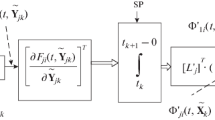Abstract
In this paper, we solve the problem of synthesis of optimal and quasi-optimal algorithms for receiving and processing sinBOC signals and cosBOC signals intended for use in global navigation satellite systems (GNSS), such as GPS (USA), Galileo (European Union), GLONASS (Russia), and BeiDou (China) based on the Markov theory of estimation of random processes by the method of reassigning the parameters of the vector of continuous processes. The problem of optimal nonlinear filtering is solved in relation to a vector discrete-continuous Markov random process for the case when its continuous part is a vector diffusion Markov process while the discrete part is characterized by a simple Markov chain for several positions. Useful BOC signals are assumed to be observed against a background of additive white Gaussian noise. Analytical relations of optimal and quasi-optimal algorithms for receiving and processing GNSS BOC signals are obtained based on the step-by-step solution of the Stratonovich equation. A block diagram of a quasi-optimal system for receiving and processing BOC signals with reassigning parameters as applied to promising GNSS is presented. The method used in this study for solving the problem of synthesizing optimal and quasi-optimal algorithms for receiving BOC signals is completely applicable for those operating GNSS modes, in which BOC signals (i.e., meander noise-like signals (NLSs)) are not used, but traditional NLSs are used.


Similar content being viewed by others
REFERENCES
V. S. Shebshaevich, P. P. Dmitriev, N. V. Ivantsevich, et al. Network Satellite Radio Navigational Systems (Radio i Svyaz’, Moscow, 1993).
Yu. A. Solov’ev, Satellite Navigation and Its Applications (Eko-Trendz, Moscow, 2003).
J. W. Betz, in Proc. 12th Int. Techn. Meeting of the Satellite Division of the Institute of Navigation (ION GPS 1999), Nashville, Sept. 15–17, 1999 (ION, Fairfax, 1999), p. 639.
J. W. Betz, Navigation J. ION 48, 227 (2001).
M. S. Yarlykov, Meander Noise-Type Signals (VOS-signals) and TheirVersions in Satellite Radio Navigational Systems (Radiotekhnika, Moscow, 2017).
J. W. Betz, in Proc. 13th Int. Technical Meeting of the Satellite Division of the Institute of Navigation (ION GPS 2000), Salt Lake City, Sept. 19–22, 2000 (ION, Fairfax, 2000), p. 2140.
Global Positioning Systems Directorate. Systems Engineering and Integration. Interface Specification IS-GPS-800–Navstar GPS Space Segment/User Segment L1C Interface, IS-GPS-800C, Sept. 05, 2012.
G. W. Hein, J. Godet, J.-L. Issler, et al., in Proc. 15th Int. Techn. Meeting of the Satellite Division of the Institute of Navigation (ION GPS 2002), Portland. Sep. 24–27, 2002 (ION, Fairfax, 2002), p. 266.
European GNSS (Galileo) Open Service Signal In Space Interface Control Document (OS SIS ICD), Iss. 1.1. Revision 1 (Eur. Space Agency, Paris, Sept. 2010).
O. Julien, C. Macabiau, and J.-L. Issler, The Radio Science Bull, No. 330, 32 (2009).
L. Lestarquit, G. Artaud, and J.-L. Issler, in Proc. 21st Int. Techn. Meeting of the Satellite Division of the Institute of Navigation (ION GNSS 2008), Savannah, Sep. 16–19, 2008 (ION, Fairfax, 2008), p. 961.
G. W. Hein, J. A. Avila-Rodriguez, S. Wallner, et al., in Proc. IEEE/ION Position, Location and Navigation Symp. of the Institute of Navigation (ION-PLANS 2006), Apr. 25–27, San Diego, 2006 (ION, Fairfax, 2006), p. 883.
A. A. Voskoboynikov and A. V. Stulov, Nov. Navigatsii, No. 2, 8 (2007).
R. L. Stratonovich, Conditional Markov Processes and Their Applications in Optimum Control Theory (Mosk. Gos. Univ., Moscow, 1966) [in Russian].
V. I. Tikhonov and N. K. Kul’man, Nonlinear Filtration and Partially Coherent Reception of Signals (Sovetskoe Radio, Moscow, 1975) [in Russian].
Yu. G. Sosulin, Detection and Estimation Theory for Stochastic Signals (Sovetskoe Radio, Moscow, 1978) [in Russian].
M. S. Yarlykov, Application of the Markov Theory of Nonlinear Filtration in Radio Engineering (Sovetskoe Radio, Moscow, 1980) [in Russian].
M. S. Yarlykov and M. A. Mironov, Markov Theory of Estimation of Random Processes (Radio i Svyaz’, Moscow, 1993) [in Russian].
V. I. Tikhonov and V. N. Kharisov, Statistical Analysis and Synthesis of Wireless Devices and Systems: School Textbook for College (Radio i Svyaz’, Moscow, 1991) [in Russian].
M. S. Yarlykov, J. Commun. Technol. Electron. 66, 34 (2021).
M. S. Yarlykov and S. M. Yarlykova, Radiotekhnika, No. 1, 11 (2010).
M. S. Yarlykov and V. Yu. Shishkin, Radiotekh. Elektron. (Moscow) 37, 260 (1992).
M. S. Yarlykov, Statistical Theory of Radio Navigation (Radio i Svyaz’, Moscow, 1985) [in Russian].
M. S. Yarlykov and K. K. Skogorev, J. Commun. Technol. Electron. 53, 1075 (2008).
M. S. Yarlykov and S. M. Yarlykova, J. Commun. Technol. Electron. 66, 899 (2021).
M. S. Yarlykov and S. M. Yarlykova, J. Commun. Technol. Electron. 51, 874 (2006).
M. S. Yarlykov and S. M. Yarlykova, Radiotekhnika, No. 7, 18 (2004).
CONFLICT OF INTEREST
The author declares that he has no conflict of interest.
Author information
Authors and Affiliations
Corresponding author
Additional information
Translated by A. Ivanov
Rights and permissions
About this article
Cite this article
Yarlykov, M.S. Optimal and Quasi-Optimal Reception of BOC Signals Based on Reassignment Algorithms in Perspective Global Navigation Satellite Systems. J. Commun. Technol. Electron. 67, 529–558 (2022). https://doi.org/10.1134/S106422692204012X
Received:
Revised:
Accepted:
Published:
Issue Date:
DOI: https://doi.org/10.1134/S106422692204012X




